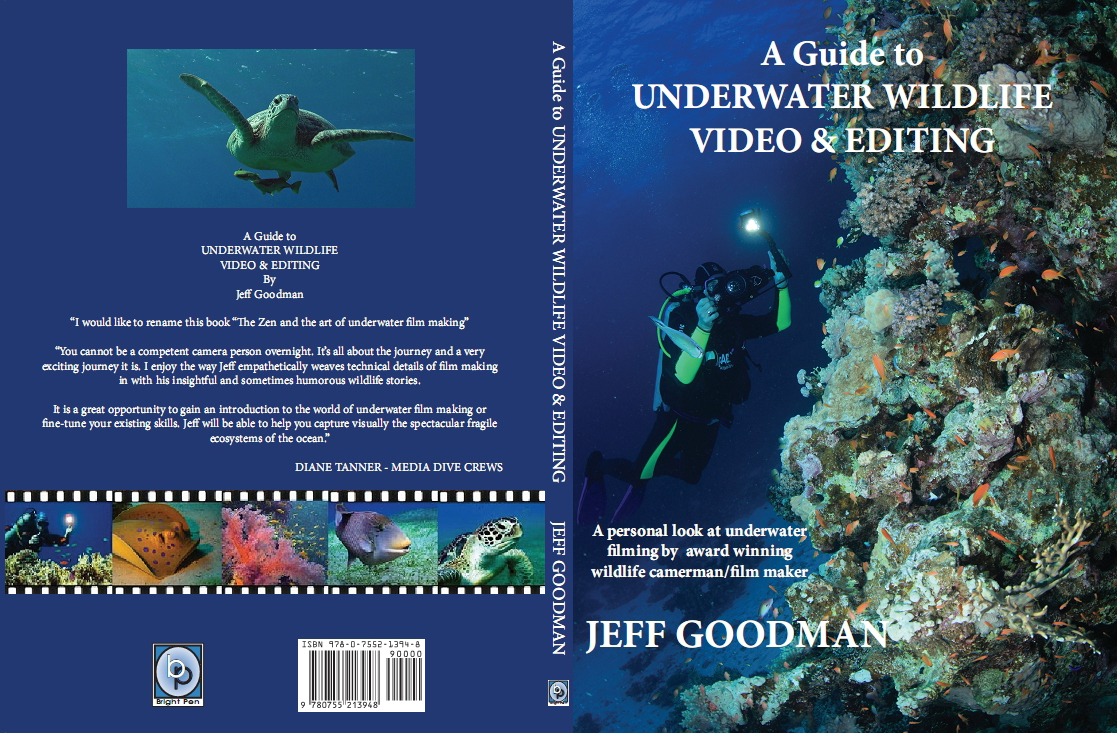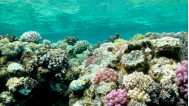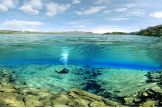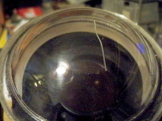Photo / Video News & Reviews
A Guide to Underwater Wildlife Video & Editing – Part 7

PART 7 – FLAT & DOME PORTS
Ports.
Having paid good money for your camera and housing, it would be a shame to now spoil your image quality with a cheap port. The optical properties of your port are as important as the lens of your camera. A low quality port would be like putting the wrong pair of spectacles on a person, so although they could still see well enough, the images would be slightly soft or degraded. Once again you usually get what you pay for. Often the problem of choosing your first port is solved for you by the housing manufacturer in that a particular housing and supplied port will be specially designed for optimum results with a particular camera and lens. It is always worth grilling the sales person that this is the case for the set-up you are interested in (In the semi-professional range of cameras and above, you can of course change camera lenses. It then becomes very important to use a compatible port).
No single port will cover all the types of filming you may like to do.
There are 3 main port types:
The flat port which is mainly useful for macro work and good close ups.
The standard dome port which covers most applications.
The wide angle dome port for videoing ultra wide angle.
The flat or macro ports are great for filming close ups and macro but because of the refractive index effect as previously mentioned, this port will decrease the natural angle of coverage of the lens and so increase the apparent image size. These ports would not be the best for videoing large subjects such as whales or wrecks, especially if the water visibility is minimal and you have to get really close to see anything at all.
The standard dome port is a good option for covering a wide range of subjects and is probably the most widely used. These standard dome ports will compensate for the 1/3rd angle of coverage loss and restore your lens to normal coverage.
The wide angle port provides the maximum angle of coverage when used with a wide angle lens and is good for getting close to the subject but maintaining a wide perspective. These are particularly useful in temperate waters where the visibility may generally not be so clear. Many manufacturers of underwater housings put in a standard port by default. More expensive housings will allow you to change ports which in effect is the same as changing lenses. Another option for some housings is to use a ‘wet’ wide angle adaptor which can be added to, or taken away from the flat port while still underwater. These ‘wet’ ports are very versatile but there is a small drop in quality when compared to a prime wide angle port.
Fisheye lens & port
A fisheye lens and port give an even greater angle of coverage, but does so with a high degree of distortion. This will vary in degree from lens to lens. The effects can be quite dramatic and are usually better used with stills photography than video.
Zooming through a dome port.
Not all dome ports, especially the cheaper ones, will facilitate a zoom and at the same time, keep focus. Auto focus can sometimes compensate for this but it is not guaranteed. And remember, if you do zoom in, then the depth of field will decrease. Generally zooming while actually filming can be very off-putting for an audience and so unless there is a very good reason for doing this then I would suggest you mainly use the function for re-sizing and framing your shot.
Scratched Ports
A scratch or mark on your port can be a real pain. Scratches are more noticeable on glass ports than on Perspex ones. This is because Perspex or acrylic is roughly the same refractive index as sea water and so scratches are effectively filled by the water and visually removed. But with glass the refractive index is different and as light passes through a scratch it behaves differently from the rest of the port glass and becomes noticeable. Under normal front, side or top-lit situations, a scratch may not be noticed but may very quickly become apparent when back-lit. With glass I’m afraid it is time to change your port. With Perspex there is the opportunity to buff the port with ‘wet & dry’ to remove light scratches. This will take hours of patient work.
In short, take care of your ports. Glass is tougher than Perspex but is far more expensive. Your choice. If you can afford it, go for glass.
CONDENSATION
Condensation and fogging in a housing can lead to missed shots and great frustration and, of course, it doesn’t become noticeable until you are underwater. The problem can occur when there is a slight amount of moisture in your housing and then that housing is put in the heat of direct sunlight. The moist air in the housing, upon being put into relatively cold water, will immediately condense on the thinnest and coldest part of that housing, which is going to be at the centre of the dome port. It rarely happens with a flat port but it is not impossible. So, you jump in the water hoping for a great video session and all you get is foggy day shots. You can see the condensation right away, but just occasionally, if you are not paying attention and the amount of moisture is very slight, the effect will be to soften the focus of your image. You may think all this is obvious but be vigilant.
The solution is to make sure your camera and housing interior are thoroughly dry and you do not leave your rig out in the hot and direct sun at any time, especially while you are kitting up. Keep the housing shaded until you get in the water.
News
Meet Insta360 Ace Pro 2: Redefining Action Cameras With Unrivaled 8K Image Quality & Smarter AI

Insta360 is thrilled to announce the latest addition to its Ace series, Insta360 Ace Pro 2. This groundbreaking wide-angle action camera delivers unparalleled image quality, smarter, easier capture powered by AI, upgraded audio, and an improved rugged design made for action at its most extreme.
Co-engineered with Leica, it delivers serious performance upgrades with the industry-first dual AI chip and state-of-the-art imaging courtesy of a new 1/1.3″ 8K sensor and Leica SUMMARIT lens with a 157º field of view. Creators can experience smoother videos with higher frame rates at 8K30fps and 4K60fps Active HDR, PureVideo for excellent low light performance, a bigger 2.5″ flip touchscreen and more.
The action camera utilizes Insta360’s advanced AI technology to offer a smarter experience from shooting to sharing. Innovative functions like the option to pause or cancel a recording, gesture and voice control, Auto Edit, and AI Highlights Assistant completely transform the experience for creators. With no more complex workflows, anyone can experience a simpler way to film and spend more time immersed in the moments they love.

Insta360 Ace Pro 2 significantly improves on its design, offering a more rugged, reliable action camera. Its waterproofing has increased to 39ft (12m), and it offers crystal-clear audio with an integrated Wind Guard and a removable Lens Guard to handle whatever you throw at it, providing full flexibility for action and sports enthusiasts.
“Our goal was to refine and enhance the groundbreaking features of the original Insta360 Ace Pro to deliver an unparalleled experience,” says JK Liu, founder of Insta360. “We are confident these upgrades establish a new industry standard. Not only do they bring significant advances in AI, they empower creators to capture what was always impossible with other action cameras, opening the door to unprecedented creative potential.”
Insta360 Ace Pro 2 is available to order today worldwide via Insta360.com, as well as trusted retailers and select authorized partners.
Unparalleled Image Quality, Day and Night
The Leica SUMMARIT lens immediately sets it apart from competitors with its state-of-the-art image quality. Combined with an upgraded 1/1.3″ 8K sensor offering 13.5 stops of dynamic range, Insta360 Ace Pro 2 delivers simply breathtaking visuals in situations other action cameras simply can’t handle.
Further contributing to its image quality and performance is the industry-leading dual-chip design. Insta360 Ace Pro 2 is the first action camera with a dedicated Pro Imaging Chip that handles image processing and noise reduction, while a separate 5nm AI Chip handles further image processing and overall camera performance, providing a smooth, seamless user experience. The dual chip also enables more shooting modes and higher specifications, such as 8K30fps video, 4K60fps Active HDR (High Dynamic Range), and upgraded PureVideo. Even in fast-moving motion and high-intensity action, creators can enjoy smooth, sharp videos thanks to the higher frame rates or slow it all the way down with crisp 4K120fps slow motion.
A complex, custom-trained AI neural network underpins PureVideo, a specialized shooting mode that drastically reduces noise and enhances details in real time for cleaner, brighter images, even in extreme low light. Whether it’s twilight strolls or evening rides, creators can record what they never could before. For the daytime, upgraded 4K60fps Active HDR brings out all the details in intense highlights and shadows for more vibrant footage. Meanwhile, a wider 157° lens FOV captures more of the surroundings, perfect for vlogging or when the scenery really matters.
Exclusive Leica-engineered color profiles infuse footage with their signature aesthetic, adding a touch of elegance to every shot. Insta360’s devotion to color accuracy is seen elsewhere with Insta360 Ace Pro 2’s ability to retain rich and precise colors, even underwater.
Ready for Action Anytime, Anywhere
The upgraded design proves to be even more rugged, ready for when you ramp up the action. Waterproofing has increased to 39 feet (12 meters) or 197 feet (60 meters) with the Dive Case, and it handles temperatures as low as -4ºF (-20ºC) with ease, perfect for winter sports and extreme climates.
The new, removable Lens Guard provides greater all-around protection, meaning creators can feel confident to push the limits further and capture the impossible, knowing their action cam is up to the challenge.
An all-new Wind Guard keeps wind and noise at a minimum during those peak moments, ready to snap on and off as you need. With refreshed audio algorithms bringing professional-grade clarity to your content, you can immerse your viewers like never before. What’s more, the magnetic mounting system lets you seamlessly switch between accessories. Less time spent unscrewing and screwing your camera and mounts, more time in the moment.
Insta360’s leading FlowState Stabilization technology ensures videos remain incredibly smooth no matter what, while 360º Horizon Lock, now applied automatically in-camera, keeps everything perfectly level. Prioritizing performance and convenience, Insta360 Ace Pro 2 sports a bigger 1800mAh battery and a new Endurance Mode that offers a 50% longer runtime at 4K30fps than Insta360 Ace Pro. Fast charging powers the battery to 80% in 18 minutes or 100% in 47 minutes, so you can get back to the action quicker.
Insta360 has expanded its compatibility with several top third-party sports accessories, allowing action and sports enthusiasts to add a new level of detail. For data-rich videos, overlay real-time stats from third-party sports brands, including Garmin, Apple, COROS, and more. Alternatively, users can add stats from their phone directly in the Insta360 app without any extra gear or use the GPS Preview Remote for easy live preview, remote control, and real-time GPS data. For moto vloggers, pair Insta360 Ace Pro 2 with your motorcycle helmet headset from Sena, Cardo, and more for clear dual-track audio and hands-free control every ride.
Made for those who demand the highest standard of action capture, Insta360 Ace Pro 2 offers the perfect combination of durability and high-quality performance to capture life’s thrills with confidence.

Smarter, Easier Capture & Editing
Insta360 Ace Pro’s flip touchscreen proved an essential and convenient tool for creators and has been further upgraded to 2.5 inches. With a 70% increase in pixel density, a 6% increase in brightness and a 100% increase in flip durability, it allows for perfect framing and easier preview for vlogging, selfies, and difficult angles, all while remaining visible under bright sunlight. Instead of guessing if your shot looks perfect, you can shoot with confidence, knowing it is.
Internally, Insta360 Ace Pro 2 offers innovative solutions to problems that have hindered action enthusiasts for years:
- 4K Clarity Zoom – Want a close-up but the image quality becomes too grainy? Zoom in and out 2x without losing quality.
- Pre-Recording – Never miss a moment with up to 120 seconds of footage saved before you even hit record.
- Gesture & Voice Control – Use quick hand signals or verbal commands to control the camera, such as start/stop recording or take a photo, ideal if it’s mounted out of reach.
- Pause/Resume Recording – Got time between shots? Hit pause and continue recording when you need to keep everything in one continuous file for easier file management and editing.
- Timecode – Seamlessly synchronizes multiple cameras for an efficient editing workflow.
Insta360’s revolutionary AI features demonstrate a commitment to making shooting and editing as accessible as possible. Anyone, regardless of their skill level, will be amazed at what they can create. For those who aren’t confident editing, AI Highlights Assistant automatically finds the best moments from a video and delivers the highlights for review, all in-camera. Creators can merge every thrilling moment into one incredible recap or choose the ones their favorites and delete any unwanted clips to save storage.
The Assistant also helps craft your next reel from your adventures and pushes it directly to your smartphone via the Insta360 app. Look back on all your Memories and share those unforgettable moments in seconds.
Acting as a full editing suite in your pocket, the Insta360 mobile app fully embraces the game-changing possibilities of AI with advanced Auto Editing, one-tap templates and creative Shot Lab effects. Instead of spending hours learning complex tools and editing workflows, AI does it all for you, bringing your clips to life with dynamic cuts and transitions. Creators can even achieve the infamous Invisible Selfie Stick effect with the AI Selfie Stick Eraser in the app for third-person views. Looking for a real twist? AI Warp uses preset or custom keywords to bring your wildest ideas to life.
Available Now
Insta360 Ace Pro 2 is available to purchase today worldwide via Insta360.com and select retailers. The Standard Bundle retails for US$399.99 and includes a Wind Guard, Battery, Standard Mount, Mic Cap, and USB-C Cable. The dual battery bundle includes the same accessories and two batteries for US$419.99.
News
Introducing the Nauticam Super Macro Converter 3

The SMC-3
Nauticam is proud to introduce the SMC-3, the latest evolution in our line of water contact optics! Designed as a renewed version of the acclaimed SMC-1, the SMC-3 boasts a lightweight build—now only one-third the weight of its predecessor—without compromising on optical performance.
SMC-3 Specifications
| Dimensions | OD 70mm x H 32mm |
| Weight in Air | 307g |
| Weight in Water | 215g |
| Max Magnification (*1) | 2.4x (lens dependent) |
| Working Distance (*1) | 51-103mm |
| Lens Construction | 3 elements in 2 groups |
| Lens Coatings | Anti-reflection Coating |
| Mount Thread Diameter | M67 |
| Depth Rating |
100mm |

Tested with Nikon AF-S VR Micro-Nikkor 105mm f/2.8G IF-ED
Key Features
- Ultra-Lightweight Design: Weighing in at just one-third of the SMC-1, the SMC-3 offers unparalleled portability for on-the-go use.
- Superior Optical Performance: Enjoy the same exceptional clarity and precision you’ve come to expect from the SMC series.
- Increased Working Distance: The redesigned lens allows for a greater working distance, meaning it’s easier to use and provides enhanced versatility.
- Premium Materials: Crafted with advanced materials to enhance durability while minimizing weight.
- Cost-Effective: Slightly more affordable than the discontinued SMC-1, the SMC-3 delivers exceptional value.
Uncompromised Optical Quality
The Super Macro Converter 3 is constructed from lenses that are precision crafted of specially formulated low dispersion optical grade glass, ground to the most demanding standards. These exceptional measures, enhanced by broadband anti-refective coatings effectively reduce common optical issues such as chromatic aberrations, coma, spherical aberration, and field deformation associated with underwater macro photography using traditional magnifying lenses. These optics are assembled in a rugged hard anodized aluminum housing, and nitrogen purged during assembly to eliminate fogging.
Stunning Magnification
When combined with a full frame camera and a 100mm or 105mm macro lens, the device converts the optical system to provide a maximum of 2.4X magnification factor. In other words, a subject area of 15.6mm X 10.4mm will fill the whole frame of a 36mm X 24mm sensor.
Improved Sharpness and Contrast
As the Super Macro Converter 3 is optimized explicitly for using together with a macro lens underwater, images captured exhibit exceptional sharpness compared with conventional magnification lenses. Thanks to the broadband multi-layer anti-reflection coating on each surface of the lenses, images also exhibit higher contrast.
Superb Light Transmission
All the lens elements installed inside the SMC are optically optimized to appropriate diameters so as to provide maximum light transmission. The SMC doesn’t suffer from vignette issues under even the most extreme conditions. The broad band multi-layer anti-reflection coating on all surfaces also greatly improves light transmission.
Optimized for Autofocus
By utilizing a specially developed algorithm in the optimization process, the SMC renders superior image quality over the full focusing range of the camera lens (which becomes ~50 to ~100 mm in front of the SMC). Also benefitting from the high brightness and contrast of the image, the autofocus system of the camera usually works acceptably well within this range.

Ample Working Distance
Even at the maximum 2.3X magnification, there is still more than 50mm of working distance between the front element and the subject with 100/105mm macro lenses. This working distance is crucial when capturing behavior with skittish subjects.
Resolution
High resolution was a primary design goal of the SMC project. This has been achieved using computer aided optimization and high grade optical glasses with unique refractive and dispersion properties. Images taken with this new system exhibit very high resolution and quality. Results have exceeded expectations, and these images rival the quality of the macro lens in air.
Smooth Bokeh
The Converter retains the optical properties of the macro lens for the whole system underwater, resulting in a blurred (out of focus) background that has a pleasing smoothness and creamy look, without the normal purple and green fringing.
Avoiding Diffraction
Due to the overall superior optical performance of the SMC-3 it is possible to shoot larger apertures with excellent image quality. This avoids reaching the diffraction limit of high resolution sensors, and allows selective focus effects with narrow depth of field in super macro images.
For more information about the Nauticam Super Macro Converter 3, which ships in November, click here.
-

 News1 month ago
News1 month agoIconic SS United States to become the World’s Largest Artificial Reef
-

 Blogs3 months ago
Blogs3 months agoNovoScuba’s Game-Changing Approach for Dive Store Owners: WE PAY YOU!
-

 News2 months ago
News2 months agoBook Review – 52 Assignments: Underwater Photography
-

 Gear News2 months ago
Gear News2 months agoDYNAMICNORD – New German diving brand enters the British market
-

 News2 months ago
News2 months agoExploring Cenote El Pit: A Diver’s Dream
-

 Gear News2 months ago
Gear News2 months agoTry BARE drysuits (and maybe even win one!) this Friday with Sea & Sea at North West Dive Fest
-

 News3 months ago
News3 months agoComing Soon – 52 Assignments
-

 News3 months ago
News3 months agoSave £200 per person per week at Pole Pole Lodge with Dive Worldwide

















